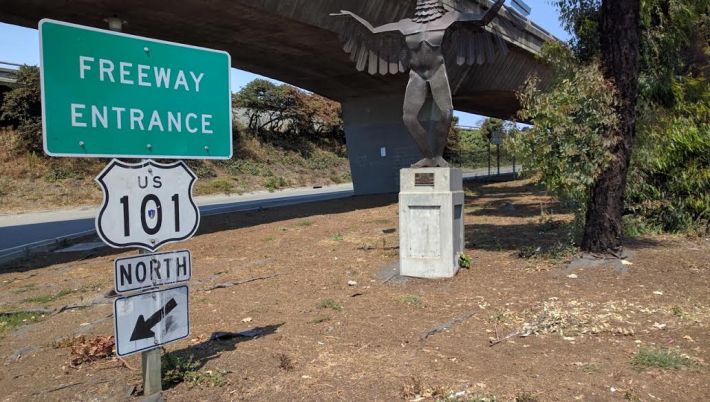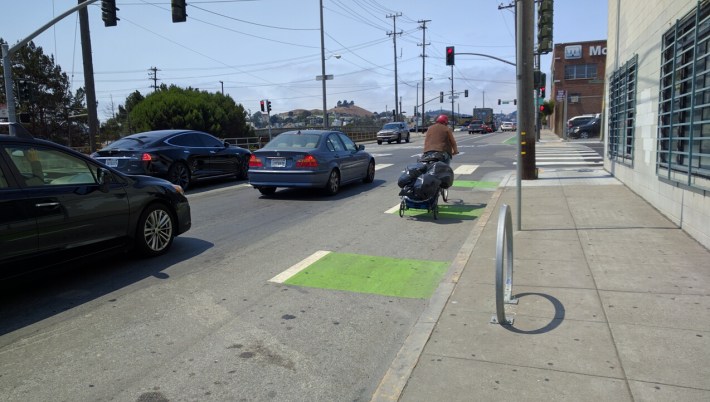
Dan Crosby works in tech and cycles to his job in SoMa, using the bike lanes and bridges along Cesar Chavez. Recently, Crosby brought this situation to the attention of Streetsblog: "There’s now a homeless encampment on the westbound Cesar Chavez bike bridge under the 101. There have often been a couple of tents there, but now there’s at least six tents, and a bunch of people standing around, ironically, a pile of bikes," he wrote in an email to Streetsblog. "Yesterday I had someone exit their tent right in front of me in the very narrow space left for me to pass, and today I had to weave around several people."
It was just two years ago that the San Francisco Bicycle Coalition (SFBC) celebrated these safety improvements to Cesar Chavez and the notorious "Hairball" tangle of freeway on-and-off ramps where the whole mess crosses 101. "Today, we celebrated Cesar Chávez Streets’ transformation into a beautiful, calmer, more livable street, complete with bike lanes, bulb-outs, a planted median and a road diet from six to four lanes," said a Bicycle Coalition release. And "A Traffic Sewer Transformed Into a Safer Street" was the celebratory headline in Streetsblog.
And now the crown jewel of the project, the bike bridge under 101, is blocked by tents and trash.
This is in no way to detract from the hard work of Fran Taylor, who lead the CC Puede movement to calm the street, reduce the lanes and make it a more livable area. Nor is it a slight to the Bicycle Coalition. Certainly, the road is much better. There are protected bike lanes for long stretches.
But the bridge is pretty much the only stretch where cyclists are completely separated from automobile traffic. It should be the safest part of the ride for Crosby and so many like him. Instead, bike riders how have to navigate around garbage and squeeze past tents and the homeless, many of whom have substance abuse problems, mental illnesses, or both. So why would homeless people want to camp in the middle of a bike lane, when there is so much empty land under the freeway and its ramps?

Scott Nelson, with the human rights committee at the Coalition On Homelessness, San Francisco, said it comes down to state versus city jurisdictions. The homeless prefer to camp, when they can, on the dirt under the 101. Obviously, it's a horrible situation, but it's one place where they're not bothering anyone and, usually, people leave them alone.
But every now and again "the highway patrol kicks everyone off of the Caltrans property, so everyone packs up their stuff and puts it on the bicycle pathways," said Nelson. "Then they wait for Caltrans to leave and then they move back down."
Mostly. Others end up staying there. Or they leave trash behind for cyclists to navigate around, as in the photo above.

Crosby, meanwhile, said he nearly crashed into a homeless man who happened to step out of a tent as he was cycling around it. He agrees: it's a matter of time before there's a bad crash. Or an altercation. And just like with car crashes, it won't be an "accident" when it happens. If city and state agencies would stop playing "homeless whack-a-mole," as Nelson called it, chasing the homeless from encampment to encampment, this could be prevented. One can also hope people will realize this isn't a zero-sum game between well-paid techies and the homeless. Crosby could get fed up and decide to get to work another way. Homeless people, on the other hand, depend on bikes--perhaps more than anyone.
"As a city, we need to do more to meet the needs of people without homes and people who bike, and we should not have to choose between those two goals," said Chris Cassidy, spokesman for the SFBC.

Caltrans, or perhaps another agency--it's often difficult to tell where one jurisdiction ends and another begins--has also put chain link fences around some of the empty land under the freeway overpasses. The homeless, explains Nelson, are desperate for shelter and many just find a way to climb over or cut through the fences, so they have someplace--anyplace--to set up their tents.

Nelson said a better solution would be to leave a dumpster for their trash, and perhaps a few portable toilets and showers, and show some humanity for the homeless and mentally ill who are trying to survive here. Instead, "They want to push them out," said Nelson. "The city needs to have a couple of spots where people can set up tents."
Requests for comment from SFPD and Mayor Edwin Lee went unanswered.The SF Department of Homelessness and Supportive Housing spoke briefly with Streetsblog and has not yet given an official statement on the matter. Streetsblog will update this story as responses come in.
"I definitely sympathize for the homeless, but one of the few pieces of completely protected bike infrastructure in the city doesn’t seem like the right way to accommodate them. Any suggestions beyond calling the police every day? Is it worth contacting SFMTA, the mayor, anybody?" asked Crosby, in his email to Streetsblog.
On those questions, Streetsblog would like to hear from its readers. Let us know what you think below.





